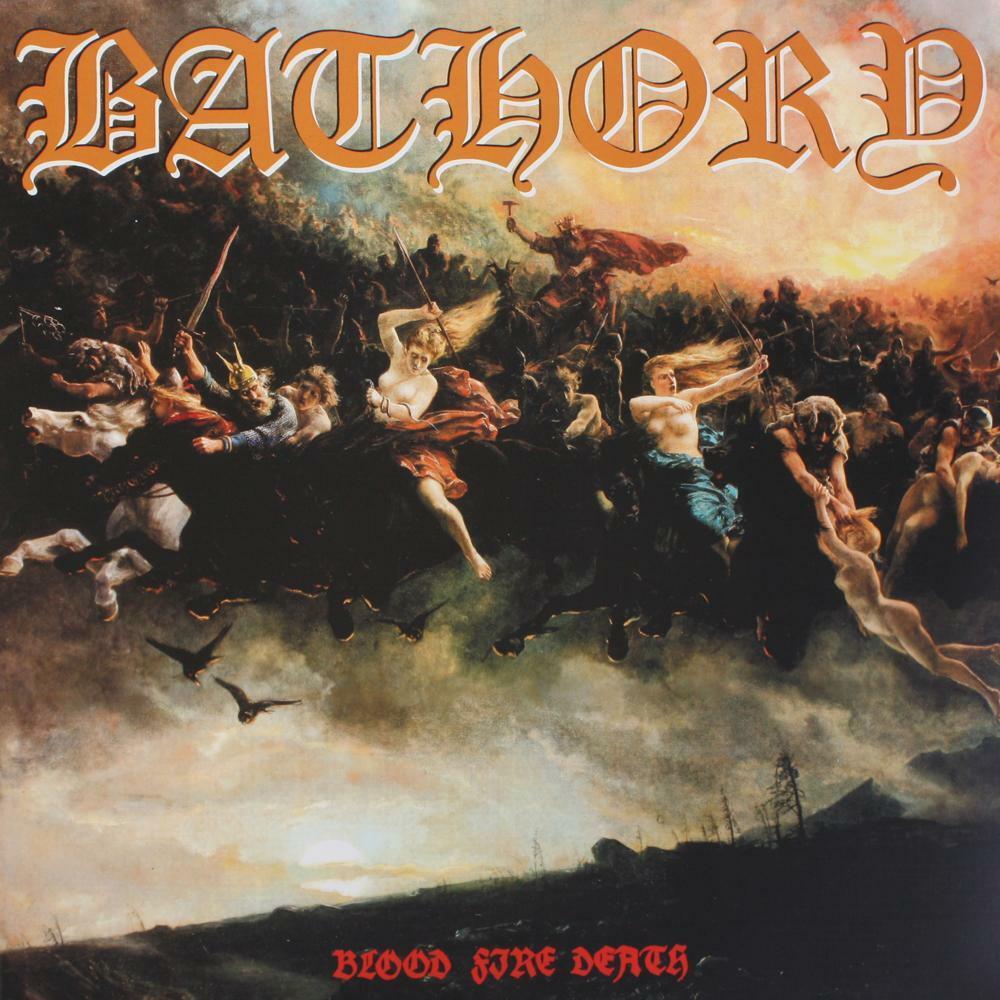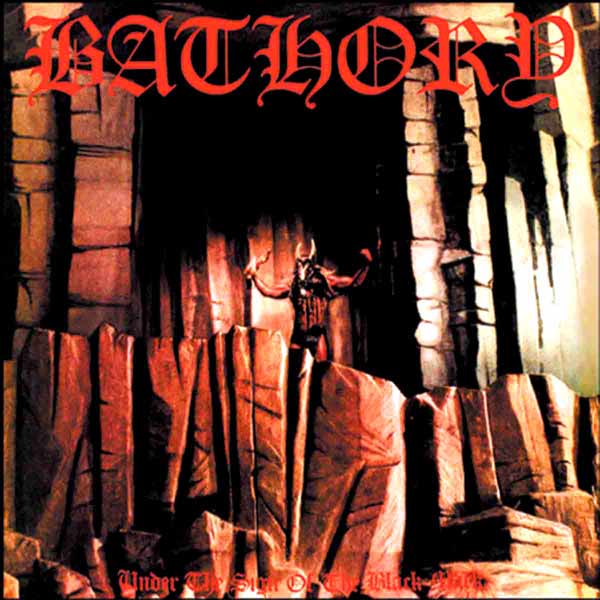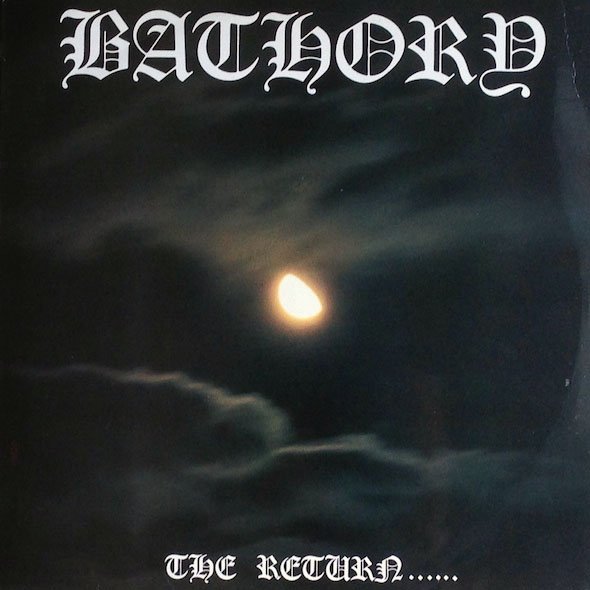Bathory
Blood Fire Death (1988)

'Blood Fire Death' is to Metal what The Iliad is to Greek literature.
The ultimate expression of battle-lore and celebration of ancient culture and mythos. The expansion of composition length and scope whilst retaining the latent styles developed on previous albums (ambient drumming, melody as theme rather than a driver of rhythmic expectation) allows Quorthon to tell tales of ancient battles and conflict, of ultimate destruction (death, loss) and ultimately creation (of heroes, folklore). Songs introduce melodic ideas (perhaps better described as motifs) and slowly conflict their individual parts, ultimately seeing their deconstruction in the cycle of the song. The album cycle is also true to this description; the earlier songs set the atmosphere of violent, yet honourable and epic battle (Odin's Ride over Nordland through Pace' til Death), the middle pieces tell of death, loss and defeat (especially Holocaust) until the album unwinds into a more reflective, highly melodic celebration of the heroic deeds of the ancient heroes (Dies Irae and Blood Fire Death), always bowing to the Gods (of death). The album, better than any after it, showcases its transition from ferocious sword fight (in the name of upholding ancient cultures) to the afterlife inscribed in myth; the mighty halls of the battle-slain, our Valhalla.
Under the Sign of the Black Mark (1987)

Under the Sign of the Black Mark is a cavernous void filled with primal savagery. Ritualistic psalms are created through a focus on ambient guitar chords played over a steady, pulsating drum beat. The aim here was to create a resonant atmosphere, rather than attempt to create harmonic or rhythmic motion. This gives the album a depth in both mood and texture. Songs are evocative, albeit not as epicly rousing as later albums, but obviously well-crafted and persistent in their ideas. For instance, melodic ideas are often fused onto the end of phrases to resolve or enhance the central idea of the previous passage, often in the form of counter-point to underlying rhythm. This adds an additional layer of emotion (or empirical data) to the experience. The primal origins of Norse black metal begin to reveal themselves, subtle complexity in atmosphere disguised under do-it-yourself minimalistic aesthetic. Raw, violent and impure.

The Return (1985)

The Return is a result of a mixture of a few of the different elements that originated in the late 1970s and early 1980s Metal and Hardcore Punk scenes. There are references to the bursting, steely energy of NWOBHM bands such as Motorhead (who themselves had some influence from punk) and the often chromatic, burst-fire tremolo power chord delivery and raw D.I.Y. aesthetic of the burgeoning punk scene. Bands such as Discharged and GBH are probably the most obvious choices here. During Bathory’s early albums, as well as Hellhammer, and to a certain extent Venom and Sodom, there was a distinct move back to the raw, exposed emotional core of Metal music. All adornments were stripped away.
Bathory also adjusted the format used by their influences to create a distinct sound. Whilst punk in particular had well-known anti-political aims, Bathory focuses more on spewing forth a vision of pure satanic ritualistic evil. Whilst techniques are similar between the two styles of music, where they diverged was Bathory’s desire to find darker chord selections and implement these in extended riff combinations. The same anarchy-themed raw energy is there and so is the pure emotion, but it is now shaped into something that is not only anti-politics, but transcends human constructs like morality altogether. When compared to hardcore punk the songs alone have not just been lengthened but so has the phrasing of the riffs and the the 'bouncy' feel that is found in a lot of those earlier bands, including Motorhead, is non-existent. Bathory also uses repetition as a device to create atmosphere. Whilst there are multiple riffs in each songs, they are often left to soak into the listener's subconscious and the music is mostly free of sharp, abrupt tempo changes.
In keeping with this the drumming is simple, there is a steady cadence, there are no needless fills or fancy tricks. Just a pulsating, trance-like beat. This comes more from a punk background than it does a Metal one, and there is very little in the way of interplay between the drums and the guitars. It also hearkens back to more primitive music and for that reason is a perfect accompaniment to the more meditative, spell-like and ritual nature of Black Metal music. Quothron's vocals are a mix of tortured screams and shrieks, and he is a dominant presence throughout, the perfect leader for these dark incantations. There is also a dark majestic undercurrent that runs throughout the The Return. The most obvious example is the surging, powerful major key riffing that runs through Born for Burning, creating a strong vision of a rising satanic force. These kinds of riffs are full of a dark sense of beauty, and the tasteful subtlety in which it is executed, makes for an enduring appeal.
In keeping with this the drumming is simple, there is a steady cadence, there are no needless fills or fancy tricks. Just a pulsating, trance-like beat. This comes more from a punk background than it does a Metal one, and there is very little in the way of interplay between the drums and the guitars. It also hearkens back to more primitive music and for that reason is a perfect accompaniment to the more meditative, spell-like and ritual nature of Black Metal music. Quothron's vocals are a mix of tortured screams and shrieks, and he is a dominant presence throughout, the perfect leader for these dark incantations. There is also a dark majestic undercurrent that runs throughout the The Return. The most obvious example is the surging, powerful major key riffing that runs through Born for Burning, creating a strong vision of a rising satanic force. These kinds of riffs are full of a dark sense of beauty, and the tasteful subtlety in which it is executed, makes for an enduring appeal.

Comments
Post a Comment